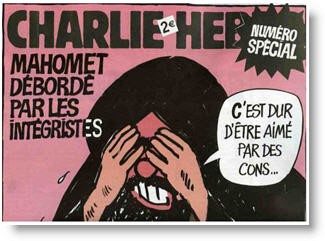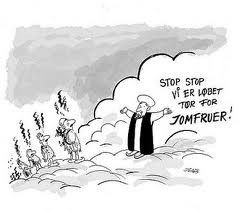Posted on January 27, 2015
By Peter Noorlander, Media Legal Defence Initiative (MLDI)
A version of this article appears in the Human Rights Action Bulletin XLIII: SPECIAL EDITION, January 2015.
The appalling murder of cartoonists, journalists and police at French satirical magazine Charlie Hebdo has reignited the debate about freedom of expression and satire—and whether some of publication’s cartoons go too far and constitute “hate speech.” Were the cartoons racist? Did they offend Islam? Is there a right not to be offended, and where is the line between offence, insult and incitement of hatred?
All but the staunchest free speech defenders will admit that the right to freedom of expression is not unlimited. Even in the US, which has the strongest constitutional protections for free speech of any country in the world, there are limits. But where is the line, particularly as regards to offensive speech and incitement to hatred?
A closer look at recent French and other European cases as well as decisions from the European Court of Human Rights may help inform this debate. France’s hate speech laws are very strict. Insulting individuals on the basis of their religion or inciting hatred is a criminal offence, as is “glorifying” terrorism. The laws are frequently used. In 2001 a cartoonist was fined for a satirising the attack on the Twin Towers, despite arguing that he intended to criticise US politics, not Islam.[1] More recently, comedian-turned-activist Dieudonné M’bala M’bala, who has been convicted several times for anti-semitism, is under investigation for posting a comment on Facebook that appeared to express sympathy with both Charlie Hebdo and one of the murderers.
Mohammed cartoons in court
Over the years, Charlie Hebdo has been sued nearly 50 times in the French courts, mostly by religious groups. Catholic groups have been the

This cartoon earned French cartoonist Denis Leroy a €1,500 fine
most litigious, followed by Islamic associations and right-wing extremist groups, which the magazine also offends with great vigour and enthusiasm. The magazine has won a vast majority of cases brought against them.[2] A number of these cases have raised the question of whether the cartoons or written materials published in Charlie Hebdo constituted hate speech.
The case that probably best illustrates the debate is the one that followed the magazine’s 2006 publication of the so-called “Mohammed cartoons” that had initially been published in a Danish newspaper, Jyllands-Posten. A coalition of Islamic groups sued Charlie Hebdo, arguing that three of the cartoons in particular insulted their religious beliefs. The first, which appeared on the cover of the magazine, showed the prophet Mohammed crying and saying, “It’s hard being loved by idiots.” The caption read, “Mohammed overwhelmed by fundamentalists.” The second showed the prophet Mohammed apparently guarding the gates of heaven and saying to a line of suicide bombers, “Stop! Stop! We have run out of virgins!” The third showed the prophet Mohamed wearing a turban in which a bomb is concealed with the fuse lit.
A Paris court ruled in 2007 that the cartoons did not incite hatred and could not be seen as “hate speech”.[3] The court emphasised the importance of protecting free speech in a democratic society, and the need to tolerate the viewpoints of others—including viewpoints that some may find offensive. The court also noted that the cartoons appeared in a satirical magazine that the public was free to buy or not to buy—they did not, for instance, appear on billboards that everyone could see. As for the cartoons themselves, the court ruled that two of the three were not aimed at all Muslims, but merely satirised violent extremists. This was not hate speech, according to the court.
Paris court ruled in 2007 that the cartoons did not incite hatred and could not be seen as “hate speech”.[3] The court emphasised the importance of protecting free speech in a democratic society, and the need to tolerate the viewpoints of others—including viewpoints that some may find offensive. The court also noted that the cartoons appeared in a satirical magazine that the public was free to buy or not to buy—they did not, for instance, appear on billboards that everyone could see. As for the cartoons themselves, the court ruled that two of the three were not aimed at all Muslims, but merely satirised violent extremists. This was not hate speech, according to the court.
The French court’s 2007 Charlie Hebdo ruling had a very simple, pragmatic message: if you don’t like the cartoons, don’t buy the magazine.
The court held that the third cartoon, showing the prophet Mohammed with a bomb in his turban, was much ‘darker’ than the others and 
could be seen as offensive to all Muslims. However, its re-publication was justified because of the international debate at the time around the “Mohammed cartoons” – its newsworthiness and Charlie Hebdo’s right to comment and contribute to this debate meant that the publication did not intend to incite hatred and could not be seen as ‘hate speech’. The decision was upheld on appeal.[4]
It may be worth recalling why Jyllands-Posten, the Danish newspaper, had published the cartoons in the first place. They did so not to provoke hatred or anger. They published the cartoons because another newspaper, Politiken, had reported that the writer of a children’s book entitled The Koran and the Life of the Prophet Muhammad had trouble finding an illustrator for it. In response, Jyllands-Posten invited members of the Danish Newspaper Illustrators’ Union to “draw Muhammad as they saw him”. Jyllands-Posten then published these cartoons as part of an article, ‘Freedom of Expression’, in which they expressed concern that a fear of upsetting Islamic sentiment was restricting free speech, citing a number of other examples including a museum that had removed artwork and translators of essays critical of Islam not wanting to be named.
The French decision wasn’t the first court ruling in Europe on the Mohammed cartoons. In 2006, a Danish court had already ruled that the cartoons were “not offensive… even if the text accompanying the pictures could be read as being derogatory and mocking … Of course it cannot be excluded that the drawings offended some Muslims. But there is no sufficient reason to assume that the cartoons are or were intended to be insulting… or put forward ideas that could hurt the
standing of Muslims in society.”[5] This case followed an unsuccessful complaint to the Danish police to have Jyllands-Posten prosecuted for blasphemy and religious insult. The public prosecutor declined to pursue the case. His detailed opinion discussed all of the cartoons and concluded that they did not constitute hate speech under Danish law.[6]
With regard to the cartoon of the prophet Mohammed with a bomb in his turban, the prosecutor decided “the drawing could be understood to mean that violence or bomb attacks have been committed in the name of Islam.” This, he said, would be a contribution to public discussion on terror and the viewpoint that religious fanaticism has led to terrorist acts, which is a legitimate exercise of the right to freedom of expression.
Furthermore, the prosecutor considered that even if the cartoon would be perceived as an insult and affront to Muslims, by suggesting that the prophet Mohammed was a violent person, this still would not be punishable as hate speech. Under Danish law, the minimum threshold for prosecution[7] as a religious ‘insult’ is that the cartoon indicates “contempt” and “debasement”, and according to the court, the cartoons did not meet this threshold.
The cartoons have popped up in various other cases elsewhere in Europe. In 2010, an atheist was convicted for leaving the cartoons in a prayer room in Liverpool’s John Lennon airport. He also left cartoons mocking Christianity, including one showing a smiling crucified Christ next to an advert for “no nails” glue. He reportedly objected that there was a prayer room at John Lennon airport at all, given Lennon’s “imagine no religion” line in Lennon’s song, Imagine. He was convicted of religiously aggravated harassment and given a suspended six-month sentence. He was also banned from carrying any anti-religious leaflets in public.[8] His multiple previous convictions, including for switching off Christmas music in a supermarket because he found it offensive, did help his case and he did not appeal the decision.
In 2007, prosecutors in the UK refused to initiate proceedings against a Cambridge University student who reprinted one of the Mohammed cartoons in the university’s magazine. In an attempt at satire, he had placed one of the cartoons next to a photo of the president of the student union but had swapped their names and added a comment that one was a “violent pedophile” and the other was “a prophet of God, a great leader and an example to us all”. Local police had wanted to prosecute but were advised that they should tell the student to just “grow up”.[9]
In the Netherlands, one of the cartoons was the focus of the prosecution of right-wing politician Geert Wilders. Wilders had published a movie which included the cartoon featuring Mohammed with a bomb in his turban, to which Wilders added, at the end of the movie, an explosion. In the movie he strongly criticised radical Islam and he was prosecuted for inciting hatred. He was acquitted on the grounds that his criticism was aimed at the religion of Islam and radical Islam in particular, not individual Muslims.[10] In its decision to acquit, the Dutch court relied in its decision on the European Court of Human Rights’ decisions in Féret v. Belgium, in which the European Court upheld the conviction of a Belgian politician who had handed out leaflets that presented immigrants as criminals,[11] and Erbakan v. Turkey, in which the Court condemned a hate speech conviction for a former prime minister of Turkey who had called for a political line to be drawn on the basis of religion.[12]
European Court: Guiding principles
As the Erbakan and Féret decisions cited by the Dutch court indicate, European human rights law treats such cases with some caution. The European Convention on Human Rights protects the right to freedom of expression as well as the right to freedom of religion, and condemns incitement to hatred.
Aside from Erbakan and Féret, which concern alleged hate speech by politicians, the European Court of Human Rights has dealt with a few cases involving inflammatory books, cartoons or artwork. In a 1991 case concerning Salman Rushdie’s Satanic Verses, a group of Muslims complained that the failure by the UK to ban the book—which they considered blasphemous—violated their right to peaceful enjoyment of their religious beliefs. The Court rejected the application on the grounds that freedom of religion did not include a right not to be offended.[13]
In a later case against Poland involving a picture of Jesus and Mary wearing gas masks, a similar complaint was also rejected. The Court held in that case that, “members of a religious community must tolerate and accept the denial by others of their religious beliefs and even the propagation by others of doctrines hostile to their faith.”[14]
When the art in question is not seen as having some broader societal value, the Court has been less sympathetic. In 1994, the European Court upheld the ban in Austria of a film which presented the Christian god as old, crippled and ineffective, Jesus as a somewhat dim “mummy’s boy” and the Virgin Mary as promiscuous. They are all portrayed as conspiring with the devil and the Austrian authorities had banned the film on the grounds that it insulted Christians. The European Court held that this did not violate the right to freedom of expression, because the filmmakers had been “gratuitously offensive” and the Austrian authorities had been correct to “prevent that some people should feel the object of attacks on their religious beliefs in an unwarranted and offensive manner.[15]
In contrast, in a 2006 ruling the Court held that a conviction for religious insult for a French newspaper article which criticised Catholic church doctrine and pointed out links with the origins of the Holocaust did violate the right to freedom of expression.[16] The Court considered that this article had contributed to a debate on the various possible reasons behind the holocaust, and that this was clearly an issue of public interest.
While the European Court of Human Rights has been building its jurisprudence in a reasonably clear direction, when it had a chance to rule on the Danish cartoons case it declined to do so. Following the Danish prosecutor’s refusal to prosecute the authors of the cartoons in Jyllands-Posten, two associations of Muslims lodged a complaint with the European Court of Human Rights. They argued that not only had the publication of the cartoons violated their rights to freedom of religion and non-discrimination, under Articles 9 and 14, but that the publication also constituted a violation of Article 17 of the Convention, which prohibits the abuse of rights to undermine other rights (in this case, the abuse of free speech to undermine freedom of religion). Unfortunately the Court avoided would have been an excellent and high-profile opportunity to establish caselaw on jurisdictional grounds (the complaints were Moroccan residents and could not establish a link with Denmark).
The European Court’s refusal to rule on the cartoons notwithstanding, its existing caselaw does provide clear direction. Its guiding principle is simple and plain: the right to freedom of expression means that democratic societies need to be able to discuss current affairs and issues that concern us all, and we need to accept that some of us hold strong opinions. That’s what tolerance and pluralism is all about. Inciting hatred against individuals simply on grounds of their religious beliefs oversteps the line; but satirising violent extremists within a religion is part and parcel of democratic society. Satirising a religion as such should also be permissible so long as any insults aren’t entirely gratuitous; but the line is crossed when hatred is incited against specific individuals on the grounds of their religious beliefs. That constitutes hate speech. This means that cartoonists have every right to satirise Islamic fundamentalism, an issue that has dominated public debate ever since the early 2000s.
[1] Tribunal correctionnel de Bayonne, 8 January 2002, upheld on appeal by the Pau Court of Appeals, 24 September 2002. The conviction was upheld by the European Court of Human Rights: Leroy v. France, application no. 36109, 2 October 2008.
[2] As reported by Le Monde, « Charlie Hebdo », 22 ans de procès en tous genres, 8 January 2015: https://www.lemonde.fr/societe/article/2015/01/08/charlie-hebdo-22-ans-de-proces-en-tous-genres_4551824_3224.html
[3] TGI Paris, 17e ch. Corr., 22 March 2007, Case no. 2007-327959.
[4] Paris Court of Appeals, 11e chamber, Section A, 12 March 2008, Case no. 07/02873.
[5] Aarhus City Court, 26 October 2006, as reported at https://news.bbc.co.uk/1/hi/world/europe/6087506.stm (full original ruling not available).
[6] The prosecutor’s reasoning is translated and included in the European Court of Human Rights’ admissibility decision in Ben El Mahi and others v. Denmark, application no. 5853/06, 11 December 2006.
[7] Under Article 140 of the Danish Criminal Code.
[8] https://www.independent.co.uk/news/uk/crime/atheist-given-asbo-for-leaflets-mocking-jesus-1952985.html
[9] As recounted by then-Director of Public Prosecutions, Ken MacDonald, in his lecture “Free Expression and the Rule of Law”, 5 March 2008: https://www.cps.gov.uk/news/articles/free_expression_05_03_08/index.html.
[10] Rechtbank Amsterdam, 23 June 2011, case no. 13-425046-09. Wilders was prosecuted for various other statements as well and was acquitted on all counts.
[11] Féret v. Belgium, case no. 15615/07, 16 July 2009.
[12] Erbakan v. Turkey, application no. 59405/00, 6 July 2006.
[13] Choudhury v. the United Kingdom, application no. 17439/90, decision of 5 March 1991 (Commission).
[14] Dubowska and Skup v. Poland, application nos. 33490/96 and 34055/96, decision of 18 April 1997 (Commission).
[15] Otto Preminger Institut v. Austria, application no. 13470/87, 20 September 1994.
[16] Giniewski v. France, application no. 64016/00, 31 January 2006.
